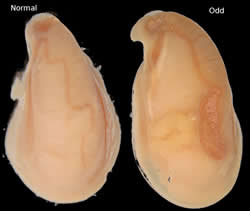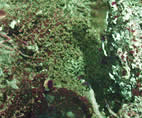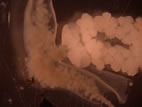
 |
| |
||||||||||||||||
|
|||||||||||||||||||||||||||||||||||||||||||||||||||||
 A normal limpet on the left and the odd one on the right. (click image for larger view) |
Hydrothermal vents are an exciting place to study for a biologist. The types of animals found there are unique and abundances are at levels unheard of in the deep sea, often matching those of some of the most productive coastal areas. The biomass of many hydrothermal vent communities is dominated by vestimentiferan tubeworms. At the vents here on Axial Seamount the tubeworm is called Ridgeia piscesase. There are many other animals at the vents including gastropods, polychaetes, and crustaceans.
Other than the tubeworms, the most abundant animal at these vents is the limpet Lepetodrilus fucensis. It is quite exciting as limpets go but from its basic appearance that can be hard to understand. From first glance they look pretty unassuming. They are generally a gray or tan colour and the largest they get is 1.5cm. So why is it exciting? It is its numbers, it is so abundant they form large carpets that cover the tubeworms and wrap around chimneys. In fact, their numbers are so great they can be seen in stacks of individuals one on top of the other.
There are a number of reasons L. fucensis is so successful. One of the most important is the different feeding strategies that is possesses. L. fucensis can graze on different surfaces as it moves around, it can suspension feed, and it has symbiotic bacteria it grows on its gill. Another thing is there are not a lot of predators that prey on L. fucensis. The majority of predators at the vents are the scale worms whose jaws are not strong enough to get through L. fucensis’s shell. So is there anything that can affect the health of the population?
During some investigations of the limpet an odd thing was noticed on a few of them. In the picture you can see a normal limpet on the left and the odd one on the right. These limpets have had their shell removed. One of the major features you can notice is the large orange coloured blood vessel running down the middle. On the one on the right you see there is a large swelling which contains some odd structure. The other thing that can be seen is the yellow mass coming off the swelling. After some further dissection we discovered that the yellow mass was comprised of eggs and there was an odd structure coming out of the swollen part of the vein.
The second picture shows the further dissection. It turns out that this is a parasite. Just looking at the parasite it is very hard to tell what type of animal it is. The initial guess is a crustacean of some sort. A closer examination of the egg mass revealed some nauplii that looked very much like a copepod. Copepods are small aquatic crustacean and are among the most abundant creatures on the planet. There are many different types – from free swimming ones, to detritus feeders and even parasitic ones. Even among parasitic copepods this one is an odd one. It has a highly modified body and seems to occupy a very tiny niche.
So what does this mean? For starters it seems to be one of the first hydrothermal vent parasites discovered. Other parasites have been seen at hydrothermal sites but this one seems to be only on the limpet L. fucensis. What does it mean for the limpet? The parasite is quite large in comparison to the limpet so it is obviously a drain on the limpet’s health. The limpet’s reproductive health is also drastically decreased. So there is the potential for this parasite to act as an important population control. And what does it mean to us? It is always exciting to discover new species and expand what we know. Also with further research perhaps a new medicine could be discovered based on the parasites ability to increase the size of the blood vessel.
So that’s the tale of the amazing limpet.
|
Sep/Oct 2004
| ||||||
| S | M | T | W | T | F | S |
| 12 | 13 | 14 | 15 | 16 | 17 | 18 |
| 19 | 20 | 21 | 23 | 24 | 25 | |
| 26 | 27 | 28 | 29 | 30 | 1 | 2 |
Today's Events:
BPR deployed
CTD Off-axis
Jason dive J2-292 at southern end of 1998 lava flow.
|
Today's
photos |
|
click
caption for larger view |
 Dissection of odd limpet. |
 Dissection of odd limpet. |
| NeMO Home |About NeMO | Expeditions | NeMO Net | Explore | Dive! | Education |